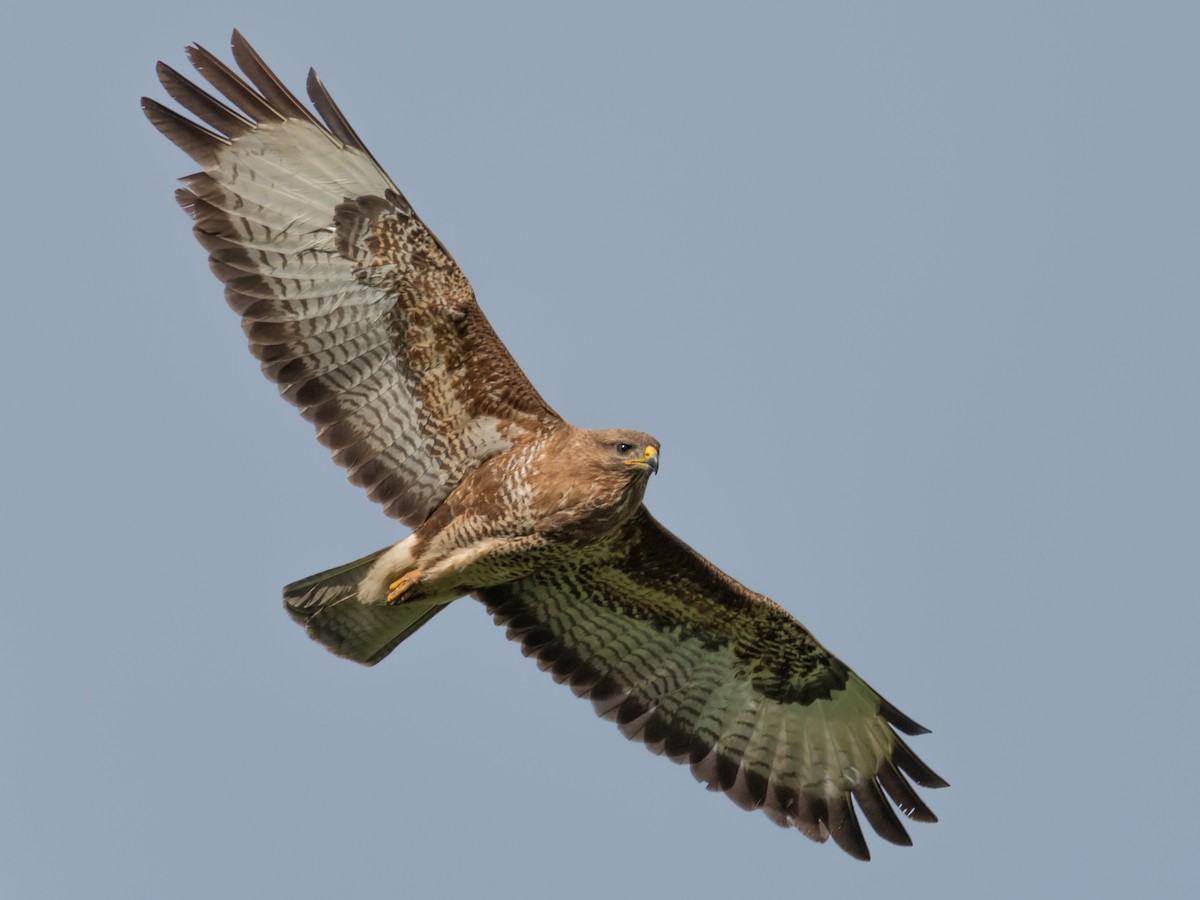
Common Buzzard
Buteo buteo
Order:
Family:
Size:
40 to 58 centimeters (16 to 23 inches)
Weight:
600 to 1300 grams (1.3 to 2.9 pounds)
Taxonomy:
(Linnaeus, 1758)
Short Description:
The common buzzard (Buteo buteo) is a medium-to-large bird of prey whose range covers most of Europe and extends into Asia. Over much of its range, it is resident year-round, but birds from the colder parts of the Northern Hemisphere typically migrate south (some well into the Southern Hemisphere) for the northern winter. The common buzzard measures between 40 and 58 cm (16 and 23 in) in length with a 109–140 cm (43–55 in) wingspan and a body mass of 427–1,364 g (0.941–3.007 lb), making it a medium-sized raptor. This broad-winged raptor has a wide variety of plumages, and in Europe can be confused with the similar rough-legged buzzard (Buteo lagopus) and the distantly related European honey buzzard (Pernis apivorus), which mimics the common buzzard's plumage for a degree of protection from northern goshawks.[citation needed] The plumage can vary in Britain from almost pure white to black, but is usually shades of brown, with a pale 'necklace' of feathers. Of the two eastern subspecies, B. b. vulpinus breeds from east Europe eastward to the Far East (including Eastern China and South Asia), excluding Japan,[8] while B. b. menetriesi breeds in the Southern Crimea and Caucasus to northern Iran.[9] B. b. vulpinus is a long-distance migrant, excepting some north Himalayan birds, and winters in Africa, India and southeastern Asia. In the open country favoured on the wintering grounds, steppe buzzards are often seen perched on roadside telephone poles. The steppe buzzard is some times split off as a separate species, B. vulpinus. Compared to the nominate form, it is slightly smaller (45–50 cm (18–20 in) long), longer winged and longer tailed. The two colour morphs are the rufous form which gives this subspecies its scientific name (vulpes is Latin for "fox") and a dark grey form. The tail of B. vulpinus is paler than the nominate form, and often quite rufous, recalling North American red-tailed hawk. The upper wings have pale primary patches, and the primary flight feathers are also paler when viewed from below. Adults have a black trailing edge to the wings, and both morphs often have plain underparts, lacking the breast band frequently seen in B. b. buteo. The common buzzard breeds in woodlands, usually on the fringes, but favours hunting over open land. It eats mainly small mammals, and will come to carrion. A great opportunist, it adapts well to a varied diet of pheasant, rabbit, other small mammals to medium mammals, snakes and lizards, and can often be seen walking over recently ploughed fields looking for worms and insects.[citation needed] When available, common buzzards feed on their preferred prey species, field voles Microtus agrestis, in relation to their abundance. When the abundance of field voles decline, common buzzards switch to foraging on a diversity of prey items typical of farmland habitats. Buzzards do not normally form flocks, but several may be seen together on migration or in good habitat. The Victorian writer on Dartmoor, William Crossing, noted he had on occasions seen flocks of 15 or more at some places.[citation needed] Though a rare occurrence, as many as 20 buzzards can be spotted in one field area, approximately 30 metres (98 ft) apart, so cannot be classed as a flock in the general sense, consisting of birds without a mate or territory. They are fiercely territorial, and, though rare, fights do break out if one strays onto another pair's territory, but dominant displays of aggression will normally see off the interloper. Pairs mate for life. To attract a mate (or impress his existing mate) the male performs a ritual aerial display before the beginning of spring. This spectacular display is known as 'the roller coaster'. He will rise high up in the sky, to turn and plummet downward, in a spiral, twisting and turning as he comes down. He then rises immediately upward to repeat the exercise. The call is a plaintive peea-ay, similar to a cat's meow. In Pakistan, Common Buzzards are irregular winter visitors, all over Pakistan. In most cases people misidentify Common Buzzards as Long Legged Buzzard due to many similarities
Far far away, behind the word mountains, far from the countries Vokalia and Consonantia, there live the blind texts. Separated they live in Bookmarksgrove right at the coast
.Lahore,Bahawalpur,Rahim Yar Khan,Kasur,Bahawalnagar,Faisal Abad,Multan,Bhakkar,Dera Ghazi Khan,Jhang,Khanewal,Khushab,Layyah,Mandi Bahauddin,Mianwali,Narowal,Nankana Sahib,Pakpattan,Rawalpindi,Sialkot,Toba Tek Singh,Karachi Central,Kashmore,Sanghar,Tando
Common Buzzards are opportunistic hunters and scavengers. They primarily feed on small mammals, birds, reptiles, and carrion. They are often observed perched on elevated vantage points, such as trees, poles, or rock outcrops, from where they scan the surrounding area for prey. They use their keen eyesight and agility in flight to hunt, often soaring on thermal currents or circling above open areas while searching for food.
Far far away, behind the word mountains, far from the countries Vokalia and Consonantia, there live the blind texts. Separated they live in Bookmarksgrove right at the coast
About Photographer : Hello World
Facebook
Twitter
Instagram
Flicker
LinkedIn

